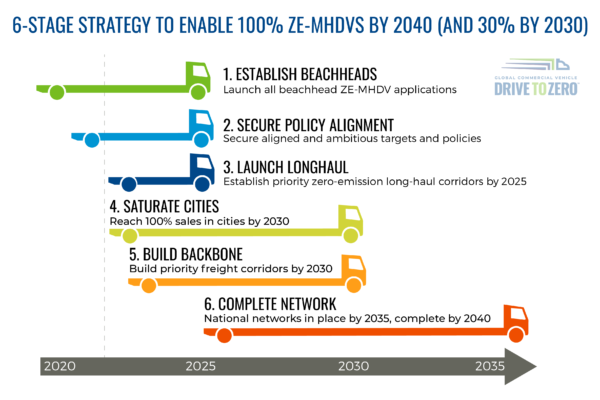This month Drive to Zero has focused on turning the goals of the Global Memorandum of Understanding (Global MOU) on Zero-Emission Medium- and Heavy-Duty Vehicles (ZE-MHDVs) into concrete action. Sixteen leading nations are working collaboratively toward a 100% zero-emission truck and bus sales target by 2040. This level of ambition requires a high level of coordination and alignment in terms of both strategy and implementation. It also begs the question, where do we start?
Drive to Zero’s Global Roadmap for Reaching 100% Zero-Emission Commercial Vehicles by 2040 breaks down an action plan to transform the global truck and bus sector and achieve Global MOU benchmarks through six stages to 100% success. Working backwards from an end state defined by a complete market transformation to ZE-MHDV sales, our new global roadmap outlines the major steps required to enable the 2040 goal. We define the key elements – including goals, metrics, and timing – within and across each stage of this roadmap.

Figure extracted from “Drive to Zero’s Global Roadmap for Reaching 100% Zero-Emission Commercial Vehicles by 2040″
As a directional document, this six-stage strategy establishes both an action plan and timeline for how to achieve Global MOU goals through an aligned set of discrete and actionable elements. Building on an established strategy and early progress in ZECV technology development and commercialization, this roadmap explains what it will take to achieve the needed infrastructure network build-out, capital investment, and operational capability required for a zero-emission transport future.
— Cristiano Façanha, Global Director, CALSTART / Drive to Zero
Program Updates
Webinar: Advanced Technology to Accelerate Zero-Emission Medium- and Heavy-Duty Vehicle Deployment
In partnership with Drive to Zero, the Atlantic Council’s Global Energy Center is hosting a virtual discussion on Thursday, June 23, from 10:00 am – 11:00 am EDT (registration is required) on the role of ZE-MHDVs to accelerate climate action and spur economic growth.
Webinar: Transatlantic Policies Enabling Deployment of Zero-Emission Medium- and Heavy-Duty Vehicles
Please join the Atlantic Council’s Global Energy Center and Drive to Zero for their second virtual discussion on Thursday, June 30, from 10:00 am – 11:00 am EDT (registration is required). This edition will focus on the role of government policy to enable deployment of ZE-MHDVs.
Pledge Partner Updates
The Drive to Zero pledge partner network continues to grow, and we are excited to welcome the following organizations that recently signed the Drive to Zero Pledge:
- Utilities and Infrastructure Providers: Zeem Solutions
- Manufacturers: OlgunCelik A.S.
The Drive to Zero pledge partner network now stands at over 135 partners working together to accelerate the market for ZECVs. Learn more about the Pledge on the Drive to Zero website.
News Updates
As Global Drive to Zero launches its 2040 strategy, manufacturers and governments alike across the world made progress advancing climate goals. In Australia, newly elected Prime Minister Anthony Albanese dramatically shifted the country’s climate policies by committing to ambitious targets for greenhouse gas emission cuts. In the United States, the White House and the Department of Transportation received praise from the Electrification Coalition for the federal government’s new draft rules for the planned nationwide electric vehicle charging network. To help delivery companies and other stakeholders calculate the benefits and operational considerations of switching to ZE first/last-mile delivery vehicles, CALSTART just launched an interactive tool called the Delivery First/Last-Mile Emissions Estimation Tool (Delivery FLEET 1.0).
Plenty of work still needs to be done to secure high-level support for medium- and heavy-duty vehicle (MHDV) electrification. In New York, six customer and conservation groups have formally asked the New York Public Service Commission to finally address issues surrounding electrifying MHDVs, not only passenger cars and trucks. Together with environmental groups, Tesla and other EV companies are lobbying the U.S. government to dedicate a large chunk of funding from the 2021 infrastructure bill to specifically go toward building MHDV charging infrastructure. In India, however, some are wondering why the government there has yet to enact policy to boost truck electrification.
Efforts to spur EV adoption worldwide have been aided by continued remarkable advances in technology. Researchers at the University of Houston published a paper about a glasslike material they developed improving solid-state battery technology, with potential EV applications. A recent McKinsey report also detailed the ways that the EV revolution could be supported by new production technologies in lithium mining. Silicon Valley-based startup Solo Advanced Vehicle Technology declared its intent to “decarbonize the logistics industry,” and is now working with Michigan-based American Battery Solutions to create battery packs for its new driverless electric Class 8 truck. In San Diego, delivery provider gofor announced a pilot project to wrap its vehicles in solar panels to turn them into mobile charging stations. New York-based Plug Power also released plans using the latest innovations in green hydrogen technology to run a plant at the Port of Antwerp-Bruges in Belgium that generates 35 tons of hydrogen a day.
Please share new information, potential partners, and innovative practices to achieve our Drive to Zero goals at info@globaldrivetozero.org. Follow us on Twitter @TeamDrivetoZero. Please feel free to share this newsletter with others.
– Justin Slosky, Technical Writer, CALSTART
News Digest
 |
Events / Reports
|
 |
Market |
 |
Fleet Deployments |
 |
Manufacturers and Models: Trucks and Buses |
 |
Government Policies |
 |
Fuels & Infrastructure |
 |
Batteries & Technology |
 |
Environment |
